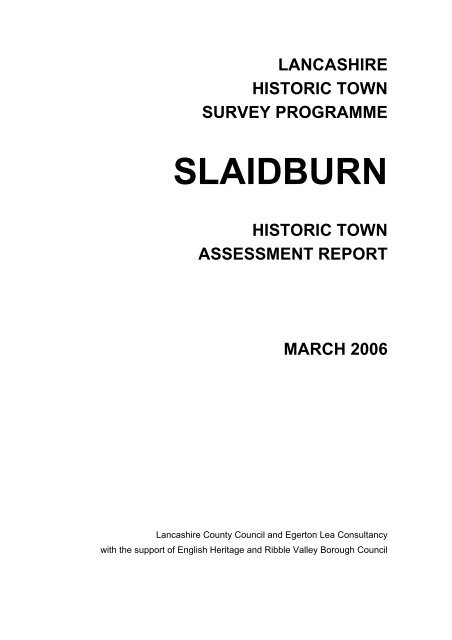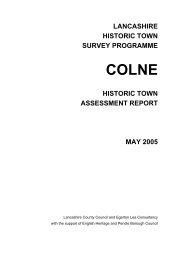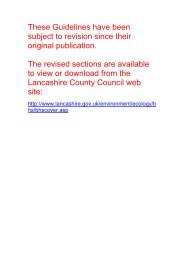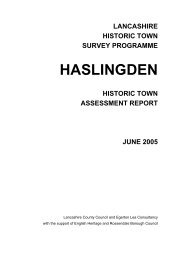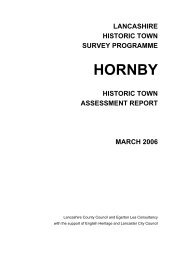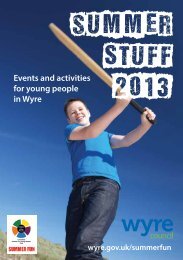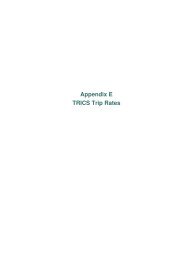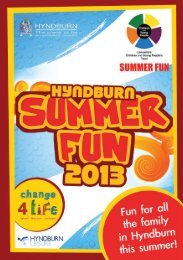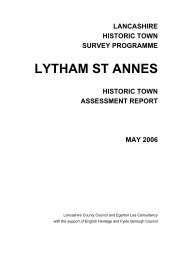SLAIDBURN - Lancashire County Council
SLAIDBURN - Lancashire County Council
SLAIDBURN - Lancashire County Council
Create successful ePaper yourself
Turn your PDF publications into a flip-book with our unique Google optimized e-Paper software.
LANCASHIREHISTORIC TOWNSURVEY PROGRAMME<strong>SLAIDBURN</strong>HISTORIC TOWNASSESSMENT REPORTMARCH 2006<strong>Lancashire</strong> <strong>County</strong> <strong>Council</strong> and Egerton Lea Consultancywith the support of English Heritage and Ribble Valley Borough <strong>Council</strong>
<strong>Lancashire</strong> Historic Town SurveySlaidburnThe <strong>Lancashire</strong> Historic Town Survey Programme was carried out between2000 and 2006 by <strong>Lancashire</strong> <strong>County</strong> <strong>Council</strong> and Egerton Lea Consultancywith the support of English Heritage.This document has been prepared by Suzanne Hartley of the <strong>Lancashire</strong><strong>County</strong> Archaeology Service, and is based on an original report written byJohn Trippier and Caron Newman. The documentary research and field studywas undertaken by John Trippier. Illustrations were prepared and processedby Caron Newman, Suzanne Hartley, Nik Bruce and Peter IlesCopyright © <strong>Lancashire</strong> <strong>County</strong> <strong>Council</strong> 2006Contact:<strong>Lancashire</strong> <strong>County</strong> Archaeology ServiceEnvironment Directorate<strong>Lancashire</strong> <strong>County</strong> <strong>Council</strong>Guild HouseCross StreetPrestonPR1 8RDMapping in this volume is based upon the Ordnance Survey mapping with thepermission of the Controller of Her Majesty’s Stationery Office. © Crowncopyright. Unauthorised reproduction infringes Crown copyright and may leadto prosecution or civil proceedings. <strong>Lancashire</strong> <strong>County</strong> <strong>Council</strong> Licence No.100023320.ACKNOWLEDGEMENTS<strong>Lancashire</strong> <strong>County</strong> <strong>Council</strong> would like to acknowledge the advice andassistance provided by Jennie Stopford, Andrew Davison, Roger Thomas,Graham Fairclough, Judith Nelson and Darren Ratcliffe at English Heritage,Paul Mason, John Trippier, and all the staff at <strong>Lancashire</strong> <strong>County</strong> <strong>Council</strong>, inparticular Lesley Mitchell, Nik Bruce, Jo Clark, Peter Iles, Peter McCrone andLynda Sutton.Egerton Lea Consultancy wish to thank the staff of the <strong>Lancashire</strong> RecordOffice, particularly Sue Goodwin, for all their assistance during the course ofthis study. The help of staff at Lancaster Library is also gratefullyacknowledged. Thanks are also due to Mary Higham for providing informationon the location of the fulling mill.© <strong>Lancashire</strong> <strong>County</strong> <strong>Council</strong> 2006
<strong>Lancashire</strong> Historic Town SurveySlaidburnCONTENTSContents..................................................................................................................................iFigures.................................................................................................................................. iiiSUMMARY............................................................................................................................ 11. INTRODUCTION .............................................................................................................. 31.1 Project background ..................................................................................................... 31.2 Project aims ................................................................................................................ 31.3 Project outputs ............................................................................................................ 41.4 Project methodology ................................................................................................... 42. LOCATION, TOPOGRAPHY AND DESCRIPTION OF STUDY AREA ............................ 72.1 Geographical location ................................................................................................. 72.2 Geology....................................................................................................................... 72.3 Landscape setting....................................................................................................... 72.4 Study area................................................................................................................... 73. SOURCES ........................................................................................................................ 83.1 Published works.......................................................................................................... 83.2 Manuscripts................................................................................................................. 83.3 Cartographic evidence ................................................................................................ 93.4 Archaeological evidence ............................................................................................. 94. HISTORICAL AND TOPOGRAPHICAL DEVELOPMENT.............................................. 114.1 Prehistoric ................................................................................................................. 114.2 Romano-British ......................................................................................................... 114.3 Post-Roman and early medieval............................................................................... 114.4 Medieval.................................................................................................................... 114.5 Post-medieval ........................................................................................................... 134.6 Industrial and modern ............................................................................................... 135. STATEMENT OF HISTORIC URBAN CHARACTER AND NATURE ANDSIGNIFICANCE OF ARCHAEOLOGICAL RESOURCE..................................................... 155.1 Surviving plan components....................................................................................... 155.2 Building materials...................................................................................................... 175.3 Housing types ........................................................................................................... 175.4 Communication networks.......................................................................................... 175.5 Spaces, vistas and panoramas................................................................................. 185.6 Plan form................................................................................................................... 185.7 Survival ..................................................................................................................... 186. DESIGNATIONS............................................................................................................. 19© <strong>Lancashire</strong> <strong>County</strong> <strong>Council</strong> 2006 i
<strong>Lancashire</strong> Historic Town SurveySlaidburn6.1 Listed buildings ......................................................................................................... 196.2 Scheduled monuments ............................................................................................. 196.3 Conservation areas................................................................................................... 197. BIBLIOGRAPHY ............................................................................................................. 208. Appendices .................................................................................................................... 23Appendix 1 – Post medieval sites as shown on figure 7................................................. 23Appendix 2 – Industrial-era sites as shown on figure 8................................................... 24Appendix 3 – Listed Buildings as shown on figure 11..................................................... 25© <strong>Lancashire</strong> <strong>County</strong> <strong>Council</strong> 2006 ii
<strong>Lancashire</strong> Historic Town SurveySlaidburnFIGURES1. Location map of survey area2. Detail of town, showing survey area and contour data3. Historic Landscape Characterisation – character areas for <strong>Lancashire</strong>4. Detail of Slaidburn as mapped in 18505. Archaeological sites recorded for Slaidburn6. Medieval sites, areas and communication routes in Slaidburn7. Post-medieval sites, areas and communication routes in Slaidburn8. Industrial era sites, areas and communication routes in Slaidburn9. Historical urban development10. Present Historic Townscape Character: HTC Types and Areas11. DesignationsPLATES1. West elevation of Slaidburn Church2. Area of staggered cross roads (possible former market place), Slaidburn with C20thwar memorial3. The Hark to Bounty Inn4. Former Girls’ School, Slaidburn5. Row of Weavers’ Cottages, 19-23 Church Street6. Wesleyan Chapel, Slaidburn© <strong>Lancashire</strong> <strong>County</strong> <strong>Council</strong> 2006 iii
<strong>Lancashire</strong> Historic Town SurveySlaidburnSUMMARYThe <strong>Lancashire</strong> Historic Town Survey ProgrammeThis assessment report is a key end product of a survey of <strong>Lancashire</strong>’s historic townscarried out by the county’s Archaeology and Heritage Service, with the Egerton LeaConsultancy, between 2001 and 2006. The project, part of a national programme of workcoordinated by English Heritage, comprised a three-stage survey of the historical andarchaeological aspects of each of the thirty-three towns selected in <strong>Lancashire</strong>. Theprogramme aims to re-evaluate the national archaeological resource and to providecomprehensive, rigorous and consistent base-line information against which research,regeneration and land use planning objectives may be set. The programme has threeprincipal outputs: new data added to the <strong>Lancashire</strong> Sites & Monuments Record, acomprehensive report (submitted as this document) that contains background informationon the historical development and the current archaeological knowledge of each town, anda shorter Historic Environment Management Guidance report, which outlines strategies forconservation and enhancement.Slaidburn – Archaeological and Historical SummarySlaidburn was mentioned in the Domesday Book as one of 12 manors belonging to thecaput, or chief manor, of Grindleton which had belonged to Earl Tostig, but which had beengranted to Roger of Poitou by 1086 (Greenwood and Bolton 1956, 7; Mills nd, 2). Shortlyafter, the manors were granted to Ilbert de Lacy. The manor of Slaidburn also included thetownships of Waddington, Bashall, West Bradford and Grindleton, and covered an arealarger than the parish, as the other townships all formed part of the parish of Mitton(Whitaker 1878, 35, Spencer 2000). The township of Slaidburn remained in de Lacy handswhilst the other townships were leased to tenants (Greenwood and Bolton 1956, 15).Slaidburn was a parish centre, and its church was clearly well-established by 1119, when itwas granted, along with the chapel at Clitheroe Castle and Whalley church, to the monks tothe Priory of St John in Pontefract by Robert de Lacy (Mills nd, 2).The de Lacy’s may have retained direct control of Slaidburn because it became anadministrative centre for the Chase of Bowland, in the mid-twelfth century, following thegrant of Bowland to Robert de Lacy in 1102 (Shaw 1956, 10). The creation of the Chase,or hunting land, of Bowland was probably a result of this grant. The original centre of thechase was at Grindleton, where the manorial or halmote court was held. The halmote courtwas transferred to Slaidburn, whilst the woodmote court was held at Whitewell (Shaw 1956,213). In the mid-fourteenth century, the Chase of Bowland had become part of theEarldom and the Duchy of Lancaster, and passed into royal hands. It was therefore treatedas part of the royal forest of Lancaster (LUAU 1997, 16). However, by the fourteenthcentury, the extent of the forest appears to have shrunk. The original boundary of theforest had included the area around Slaidburn and villages along the Ribble, but at thistime, as these areas were no longer forested, they were not subject to forest law (Grant1991, 168-9), yet forest officials continued to collect rent from them.In 1258, the lord of the manor of Slaidburn had a mill and 34 acres of demesne land. Inaddition, there were three tenants holding 85 acres and four cottagers, as well as variousmen holding a total of 316 acres of assarted land, that is land brought into cultivation fromthe waste, and for which they paid no rent. It is unclear where the assarted land was, but italmost certainly refers to land on the edge of the moorland, and may represent settlementdispersed across the township. Their rent-free status indicates that the lord of the manorwas keen to encourage settlement. It is likely that they originally formed part of the forest,but settlement expansion, through assarting, led to the exclusion of these areas as forest(Porter 1980, 26). The lord of the manor probably saw settlement as a greater source of© <strong>Lancashire</strong> <strong>County</strong> <strong>Council</strong> 2006 1
<strong>Lancashire</strong> Historic Town SurveySlaidburnincome than the forest, whilst the inhabitants of Slaidburn were entitled to underwood andtimber from it (Porter 1994, 55).Slaidburn’s urban potential was founded in its role as a parish centre, the seat of themanorial court, and the encouragement of rent-free land to new settlers. This was furtherenhanced in 1294 when Henry de Lacy obtained the right to hold a four day fair therearound the feast of St Peter ad Vincula, that is 31 st July to 3 rd August (McCutcheon 1940,165). Slaidburn never appears to have received a market charter, however (Porter 1980,58). In 1591, Saxton’s map clearly shows a market cross at the junction of Chapel Streetand the Shay (Higham 1985, 4). Administratively, Slaidburn continued to play an importantrole. In 1577, for example, a court baron was held there to which the whole of the purlieuto the east of the River Dunsop owed suit (Shaw 1956, 213). The cattle fairs continued tobe successful, and by 1770 were being held four times a year (McCutcheon, 1940, 176).Slaidburn’s population remained fairly static at over 50 households, or around 250 people,in the later medieval period (Porter 1994, 29), and it does not appear to have attracted localimmigration, possibly because it could not overcome Grindleton’s more accessible locationand proximity to Clitheroe (Higham 1978, 133). Between 1522 and 1624, however, 39dwellings, 24 outhouses and 53 other buildings were erected across the township (Porter1976, 9), and as a result, Slaidburn grew from 56 to 98 households between 1539 and1664 (Porter 1980, 30). This would have made a township population of around 450people, and was probably because of the encouragement of enclosure in 1608 by James I,who saw copyhold rents as a more profitable use of land (Porter 1980, 30).Although Slaidburn was an important administrative centre in the sixteenth andseventeenth centuries (Porter 1994, 117), it never gained the necessary impetus tobecome a town. Through the post medieval period, however, it remained a significant ruralcentre, and was the largest village in Bowland until the nineteenth century. Populationgrowth slackened after 1630, and declined from 1670, with burials exceeding baptismsover the next 30 years. After 1700, however, the population began to rise as a result ofhandloom weaving (Porter 1994, 81), and by 1801 the population of Slaidburn townshipstood at 631. The population reached its peak in 1831, to 920 inhabitants, after whichthere was a continuous decline. In 1851 it had fallen to 708, and by 1901 it stood at only381 (Kent 2002, 541).© <strong>Lancashire</strong> <strong>County</strong> <strong>Council</strong> 2006 2
<strong>Lancashire</strong> Historic Town SurveySlaidburn1. INTRODUCTION1.1 Project backgroundThis report is an archaeological and historic urban landscape assessment of Slaidburn andforms part of the <strong>Lancashire</strong> Historic Town Survey. The survey comprises an assessmentof thirty-three towns within the county, with a report produced for each town.The <strong>Lancashire</strong> project is part of English Heritage’s national Extensive Urban SurveyProgramme, which grew out of the Monuments Protection Programme. This still ongoingprogramme aims to re-evaluate the national archaeological resource and to providecomprehensive, rigorous and consistent base-line information against which research,regeneration and land use planning objectives may be set. The recognition that urbanareas themselves are archaeological monuments has led to a shift away from theidentification of individual sites within towns to a more holistic appreciation of the entirehistoric urban fabric.The <strong>Lancashire</strong> project is being undertaken by <strong>Lancashire</strong> <strong>County</strong> <strong>Council</strong> with EgertonLea Consultancy and is funded by both the <strong>County</strong> and English Heritage. It is based on asurvey commissioned by <strong>Lancashire</strong> <strong>County</strong> <strong>Council</strong> and carried out by the LancasterUniversity Archaeological Unit in 1997, which resulted in the compilation of the <strong>Lancashire</strong>Extensive Urban Archaeological Survey Assessment Report in January 1998 (LUAU1998a). This report was used to develop a specification for the assessment of individualtowns, the <strong>Lancashire</strong> Historic Town Survey Project Design, which was submitted by theArchaeology and Heritage Service of the Environment Directorate of <strong>Lancashire</strong> <strong>County</strong><strong>Council</strong> to English Heritage in January 2001. The full project commenced later in 2001 withthe compilation of first stage reports by Egerton Lea on the pre-1900 historic elements ofeach town. To this the <strong>Council</strong>’s Archaeology and Heritage team have added post-1900data and an overall assessment of the nature and significance of the resource, to producethis report.1.2 Project aimsThe principal aim of the project has been to review and evaluate the archaeological andhistorical resource for the thirty-three defined towns within the post-1974 county of<strong>Lancashire</strong>. The resource was identified and assessed for significance, and strategieswere proposed for its management.Key objectives included the• quantification of previous archaeological work,• analysis of urban origins and development,• identification and assessment of the broad historic character of each town,• assessment of the potential for the preservation of significant archaeologicaldeposits, and the• identification of future research objectives.The assessment was then to be used to help define new archaeological and conservationguidance strategies for each town. The Historic Town Survey for <strong>Lancashire</strong> forms part ofthe developing <strong>Lancashire</strong> Historic Environment Record Centre (an expanded version ofthe <strong>Lancashire</strong> Sites and Monuments Record). Here it is maintained as a nested datasetamongst the other conservation datasets used to assist in planning decision-making withinthe county (LCC 2001).© <strong>Lancashire</strong> <strong>County</strong> <strong>Council</strong> 2006 3
<strong>Lancashire</strong> Historic Town SurveySlaidburn1.3 Project outputsPrincipal project outputs include• Sites and Monuments Record (SMR) data. New information added to the<strong>Lancashire</strong> Sites and Monuments Record. The SMR is the primary database forinformation on historical sites and archaeological remains in the county. It is usedas a research and planning tool and is consulted as part of the developmentprocess.• Historic Environment GIS Data. GIS-based information, supplied to those districtswith the technology to receive it. The information includes data relating to SMRsites and statutory designated areas, the development of the individual towns overtime, and the historic plan components that make up the present urban area.• Historic Town Assessment Report. A comprehensive report, submitted as thisdocument, that contains background information on the historical development andthe current archaeological knowledge of each town. It also describes the historicalinterest of the surviving buildings, structures and plan components. Theassessment report forms the basis for the strategies submitted as HistoricEnvironment Management Guidance.• Historic Environment Management Guidance. Based upon the assessmentreport, the final stage of the survey involved the formulation of a strategy forplanning, conservation and management of the historic environment within eachtown. The strategy is presented as guidance with recommendations for localauthorities and key agencies.All the outputs, but in particular this Historic Town Assessment Report and its linkedHistoric Environment Management Guidance, will be used to inform a variety of planning,regeneration and research requirements, including:o The continuing preparation of Local Plan policy and the preparation of LocalDevelopment Frameworks and thematic or Area Action Plans;o Adoption as Supplementary Planning Documents;o Input into Community Strategies and other neighbourhood initiatives;o Input into regeneration and tourism strategies;o Providing a context for Conservation Area appraisal, review and the establishment ofnew Conservation Areas;o Facilitating the decision-making process for Housing Renewal initiatives, particularlywithin and adjacent to the East <strong>Lancashire</strong> Pathfinder areas;o Input into National, Regional and Local Research frameworks.It is intended that this assessment report and the management strategies should beaccessible not only to planners, prospective developers and others involved in the planningprocess, but also to all those who have a general interest in a particular town and itshistoric environment. To this end, the information will also be made available on the<strong>County</strong> <strong>Council</strong>’s website and at public libraries and record offices.1.4 Project methodologyThe project is based on the developing mechanisms for Extensive Urban Survey that havebeen applied elsewhere in England; these include the initial assessment undertaken forTetbury in Gloucestershire (Heighway 1992), and work carried out in Cheshire, Essex andSomerset. In addition the recent Cornwall Industrial Settlements Initiative has influencedthe approach, as many of <strong>Lancashire</strong>’s towns owe their urban origins to industrialisation.© <strong>Lancashire</strong> <strong>County</strong> <strong>Council</strong> 2006 4
<strong>Lancashire</strong> Historic Town SurveySlaidburnThe <strong>Lancashire</strong> survey includes an additional aspect, however – urban characterisation.This specifically targets the broad archaeological and built heritage resource of thenineteenth-century industrial towns, a distinctive and significant feature of <strong>Lancashire</strong>’shistoric landscape. This aspect reflects the growing emphasis placed on characterisationfor managing change in both the rural and urban environments. It also reflects theimportance of local character in the definition of a sense of place, as emphasised in EnglishHeritage’s policy statement Power of Place (2000).The methodology adopted for the <strong>Lancashire</strong> project followed the three-stage process ofmany of its predecessors, comprising:• Stage 1 – Data-gathering• Stage 2 – Assessment• Stage 3 – Strategy.The data-gathering methodology involved historical research and a field visit. Mostinformation was entered directly into the <strong>Lancashire</strong> Historic Town Survey database, whichwas developed from existing databases. This was then used for analysis and, through theuse of the ArcView GIS program, for the production of coloured base maps showing sites,designations, development phases, historic plan components and character areas.The field visits examined the modern topography of each settlement, assessed likely areasof survival and destruction of deposits and structures, and created a basic photographicrecord in monochrome print and colour digital formats.The assessment stage tries to answer two broad questions: firstly ‘How has the settlementdeveloped over time?’ and secondly, ‘What is the physical evidence of the past in today’stownscape?’In answering the first question the assessment included a chronological appraisal of thedevelopment of each town under the following headings:• Prehistoric – up to cAD70• Romano-British – cAD70-400• Post-Roman and Early Medieval – 400-1050• Medieval – 1050-1550• Post-Medieval – 1550-1750• Industrial and Modern – 1750-presentThese chronological ‘snapshots’ or ‘timeslices’ (presented below in Section 4) offerdescriptions of settlement history that will include many buildings, structures and land usesthat no longer exist today, but which afford greater understanding of how the town hascome to look as it does. It is arranged from the perspective of the distant past lookingtowards the present.To answer the second question, ‘What is the physical evidence of the past in today’stownscape?’, the assessment stage included an appraisal of the surviving historiccharacter of each town. This effectively reverses the approach outlined above, to view atown from today’s perspective, but acknowledging the time-depth evident in the place. Forexample, the analysis does not attempt to reconstruct the medieval town, but instead mapsthe medieval elements (be they buildings, roads or other patterns) that survive in the townof today.In order to do this each town was divided into a series of discrete and identifiable blocks oftownscape that share common characteristics of date, building form and function. Theseplan components are generic in that they may be found across the county – ‘Bye-law© <strong>Lancashire</strong> <strong>County</strong> <strong>Council</strong> 2006 5
<strong>Lancashire</strong> Historic Town SurveySlaidburnterraced housing’ for example – and are termed Historic Urban Character Types. However,at a detailed local scale they will show unique differences resulting in the most part fromalternate histories – for example the bye-law terraces of Darwen will differ from those inBlackpool. These are termed Historic Urban Character Areas. Differences between areasof the same character type may also be found in terms of condition and survival, or in thepresence and absence of individual structures. It follows that one character type maysupport a large range of character areas. The Historic Urban Character Areas for eachtown, grouped under their relevant Type, are described below in the Statement of HistoricUrban Character.Once Historic Urban Character Types had been identified, they were assessed accordingto the following criteria (the equivalent criteria used by the Secretary of State for schedulingancient monuments are shown in parentheses):• Townscape rarity (period, rarity) – of urban character types and subtypes.• Time depth (period, survival, diversity, potential) – visibility, survival and potential ofevidence for earlier periods (both urban and non-urban) within the type.• Completeness (group value, survival) – measure of association with buildings andfeatures and their survival; also measure of association with adjacent areas oftownscape.• Forces for change (fragility/ vulnerability). Measured through datasets includingindices of deprivation, allocation as derelict land or brownfield, allocation within LocalPlans or other redevelopment proposals, local authority housing stock informationand census data.Assessment that culminated in the mapping and evaluation of current historic charactertypes within the town of today formed the starting point and foundation for the developmentof strategies for the future. The final stage of work, the preparation of Strategy, comprisedthe preparation of Historic Environment Management Guidance for every surveyed town.The primary aim of the Strategy was to produce management guidance for conservationand enhancement. To facilitate this the historic environment within <strong>Lancashire</strong>’s towns wasdivided into individual assets and broader areas for which appropriate strategies weredevised.© <strong>Lancashire</strong> <strong>County</strong> <strong>Council</strong> 2006 6
<strong>Lancashire</strong> Historic Town SurveySlaidburn2. LOCATION, TOPOGRAPHY AND DESCRIPTIONOF STUDY AREA2.1 Geographical locationSlaidburn is situated at the confluence of the Croasdale Brook and the River Hodder atNGR SD 711 524 (centred), on the B6478 road from Clitheroe to Long Preston. Thesettlement is orientated east-west, with some development south towards the church.There is very little modern development in the village, and its extent is similar to that of thenineteenth century. It is situated around 11km from Clitheroe to the south and more than15km from Settle, to the north-east.2.2 GeologyThe underlying solid geology of the area consists of Carboniferous Limestone of theDinantian series (IGS 1979). The overlying drift geology comprises slightly calcareousglacial till derived from the Carboniferous parent materials (Countryside Commission 1998,98). This boulder clay gives rise to loam over clayey soils, often stony with impededdrainage. These are associated with peaty topped soils and better drained, mainly stonyloamy soils. The soils create land suitable for dairying, stock-rearing and forestry (SoilSurvey of England and Wales 1974).2.3 Landscape settingSlaidburn formed as a nucleated settlement at the confluence of the Croasdale Brook andRiver Hodder on the edge of the Bowland Fells. The modern village covers most of thehistoric settlement which was a valley settlement built on a terrace between the two watercourses. The settlement lies at around 144m aOD, falling gently down towards the RiverHodder at 139m aOD. The surrounding countryside is rolling, rising sharply to the northand west to the upland massif of the Forest of Bowland. The land rises more gradually tothe south towards Eastington Fell.Slaidburn lies within an area of species-poor grassland, with rough pasture at the moorlandescarpment transition (Countryside Commission 1998, 86). In the past, Slaidburn’sagrarian economy was pastorally based, with both dairy and sheep farming. Dairy farminglargely involved the production of butter and cheese (www.slaidburn.org.uk/agriculture).2.4 Study areaSlaidburn’s urban area could not be defined in relation to <strong>Lancashire</strong>’s Historic LandscapeCharacterisation Project, which outlined urban areas in accordance with their extent c1990. No urban area was defined for Slaidburn as its built up area was too small to besignificant at the scale of resolution used by the Historic Landscape CharacterisationProgramme. For the purposes of the Extensive Urban Survey an urban area was definedwhich related largely to the present built up area of the settlement with the inclusion ofTownhead.© <strong>Lancashire</strong> <strong>County</strong> <strong>Council</strong> 2006 7
<strong>Lancashire</strong> Historic Town SurveySlaidburn3. SOURCES3.1 Published worksThere are limited antiquarian sources for Slaidburn, perhaps because of its isolatedposition and its lack of local families of distinction. The most ancient family of the area, theHammertons, had left their ancestral home by 1548 (Whitaker 1878, 41; Greenwood andBolton 1955, 17). The earliest detailed accounts are provided by TD Whitaker in An Historyof the Original Parish of Whalley and Honor of Clitheroe, first published in 1801 (4 th edition1876) , and in The History and Antiquities of the Deanery of Craven in the <strong>County</strong> of York,first published in 1805 (3 rd edition 1878). Whitaker’s text is mainly concerned with thehistories of the local families and the church, and has little to say about the village itself. Inboth Baines’ History, Gazetteer and Directory of the <strong>County</strong> of York, 1, West Riding, (1822)and White’s History, Gazetteer and Directory of the West Riding of Yorkshire (1838),Slaidburn is merely described as a village on the River Hodder in the Liberty of Bowland.The Victoria <strong>County</strong> History for Yorkshire is incomplete, and as of 2002, the volumescovering the West Riding of Yorkshire, which includes Slaidburn had not been started (Kent2002, xiv).The only dedicated history of Slaidburn was published in 1922, entitled A Short History ofthe Parish of Slaidburn (Peel 1922). The work covers all the subsidiary manors of theparish and their families, and therefore there is little on the physical development andhistory of the village itself. R Cunliffe Shaw’s The Royal Forest of Lancaster (1956)contains many references to Slaidburn and its relationship to Bowland generally, as doesGreenwood and Bolton’s Bolland Forest and the Hodder Valley (1955). Greenwood andBolton’s work also incorporates Colonel J Parker’s ‘Bolland’ which was read before theSociety of Genealogists in 1926. More recently, there has been a series of works by Porteron the Forest of Bowland (1974, 1976, 1980, 1994), which provide useful details on thelandscape history of the area, including Slaidburn. The only works which deal specificallywith the centre of the village are short guides, such as MC Higham’s Slaidburn: A Guide forVisitors (1985) and S Barnes’ Slaidburn: A Discovery Trail (1985). There are twopublications on the church; an unpublished typescript ‘History of the parish church of StAndrew, Slaidburn in the West Riding of the <strong>County</strong> of York’ (Mills nd), and ‘Through all thechanging scenes: an illustrated history of Slaidburn Parish Church (Bradley 1997). There isalso A History of Methodism in Slaidburn and the Wesleyan Methodist Chapel (Spencer2003).Slaidburn’s industrial history is covered in Industrial Heritage: A Guide to the IndustrialArchaeology of the Ribble Valley by Mike Rothwell (1992). This provides a thoroughdescription of the corn mill at Slaidburn and evidence for hand-loom weaving. Moredetailed evidence for the local textile trade can be obtained from the various indexes andtranscripts of wills, parish registers and census information compiled by CJ Spencer(1999a; 1999b). These unpublished typescripts are available at Clitheroe local library andthe <strong>Lancashire</strong> Record Office in Preston (LRO) as well as at Slaidburn Heritage Centre.Slaidburn’s history is also detailed in a village website (www.slaidburn.org.uk), which looksat the agricultural industry as well as customs, traditions and people.There are two main theses which cover the Forest of Bowland, including Slaidburn. Thefirst is a PhD thesis by J Porter, on ‘The reclamation and settlement of Bowland withspecial reference to the period 1500-1650’ (1973), and the second is an MA thesis by MCHigham, on ‘The Forest of Bowland: a study in continuity (1978).3.2 ManuscriptsAlthough Slaidburn formed part of the Honor of Clitheroe, it had a separate series of courtrolls, because it was the administrative centre of the manor, and was the main centre and© <strong>Lancashire</strong> <strong>County</strong> <strong>Council</strong> 2006 8
<strong>Lancashire</strong> Historic Town SurveySlaidburnof the liberties or purlieu of Bowland. Court rolls survive for 1392-3 and from 1519onwards, and are held in the <strong>Lancashire</strong> Record Office, Preston (LRO DDX/1427 acc4833), except for the year 1515 which is in the National Archives in Kew (PRO). The rollsare written in legal Latin up to 1732, and then in English. Those for 1703 to 1733 havebeen transcribed in three unpublished volumes (Spencer 2000) copies of which areavailable in the LRO and local libraries.The <strong>Lancashire</strong> Record Office in Preston (LRO) contains only a few records relatingspecifically to Slaidburn. These include a copy of a royal decree and commission of 1619concerning the commons and waste land of the manor (LRO DDX/712 acc 6160), copies ofthe royal decree settling a copyhold dispute in 1610 in an uncatalogued collection (LRODDX/712), and there are also documents in the Parkers of Browsolme collection (LRO DDBbox 1, bundle 2). In addition, there are Methodist chapel minutes and accounts from 1830to 1976 (LRO MC1 acc 6497), and the Brennand’s Endowed School records from 1867 to1949 as well as a copy of John Brennand’s will (LRO PR 3035 acc 4255). Until 1974Slaidburn was within the West Riding of Yorkshire, and some archives are contained inYorkshire Record Offices in Wakefield and Leeds. The West Yorkshire Archives Service(WYAS) catalogue is available on-line at www.archives.wyjs.org.uk. There are 22 entriesfor Slaidburn, some individual documents, but others are bundles of deeds forming part ofmuch larger collections. There may be other relevant documents in both the LRO andWYAS under collections for the Forest of Bowland, for example the Parkers of Browsolmecollection (LRO DDB), which comprises 197 boxes. There are also deeds for the Bowlandestates from 1622 to 1806 held under LRO DDX 291 acc 3901, deposited by the Society ofGenealogists.There do not appear to be any published collections of old photographs of Slaidburn, but acollection is held at the village visitor centre on Church Street. Some photographs can alsobe found on the village website (www.slaidburn.org.uk).3.3 Cartographic evidenceThere are a number of maps of Slaidburn from the end of the sixteenth century. Theearliest known map is dated to 1592, and is held in the National Archive, Kew (PRODD/44/468), whilst the LRO holds a number of maps, including a plan of the townfieldfrom1758 by RC Clapham (LRO DP/453/1), and a map of 1765 by JB Lang of the wholesettlement (LRO DDb 84/1). There is also the tithe map and accompanying schedule of1843 (LRO PR 3035/4/1). All these maps can be viewed on the Slaidburn village website(www.slaidburn.org.uk). Saxton’s county map of 1591 shows Slaidburn with a possiblemarket cross, and Jeffrey’s Map of Yorkshire (1771) provides a good indication of theextent of settlement in the late eighteenth century.There were no other plans available other than Ordnance Survey maps. The OrdnanceSurvey maps include the 1:10,560 first edition map of 1850, surveyed in 1847 (sheet 165),and the 1:2500 maps of 1893, revised in 1907 and published in 1909 (sheet 165.01).3.4 Archaeological evidenceFollowing an initial examination of the nineteenth and early-twentieth century OS mapping,undertaken at the commencement of the LEUS there were 52 sites recorded for Slaidburnin the <strong>Lancashire</strong> Sites and Monuments Record (LSMR). Of these 40, or 77%, were listedbuildings. The majority of the remainder were structures recorded from the OrdnanceSurvey map coverage or other nineteenth century documentary sources. Only three siteswere known to have medieval or early medieval origins, and 20 had origins pre-dating1800. Most of these earlier sites are recorded on the LSMR because they are listedbuildings, and this is also a reflection of the lack of archaeological work carried out inSlaidburn to date.© <strong>Lancashire</strong> <strong>County</strong> <strong>Council</strong> 2006 9
<strong>Lancashire</strong> Historic Town SurveySlaidburnThere is only one archaeological survey known to have been undertaken in Slaidburn, atrial excavation to the rear of the church in 1984, in an area known as Balaam’s Grove.The excavations were of Bronze Age remains from a possible burial cairn(www.slaidburn.org.uk). A pilot survey of the buildings of Slaidburn was carried out by theWomen’s Institute in 1998 and 1999, using references from an earlier Ribble ValleyBorough Survey of 1983. The pilot survey comprises four volumes of photographs andnotes regarding the structural details of houses and other buildings, and can be consultedat the village visitor centre (Mason nd). A further volume deals exclusively with the lateseventeenthcentury house, Knott Gate (PRN 18144).© <strong>Lancashire</strong> <strong>County</strong> <strong>Council</strong> 2006 10
<strong>Lancashire</strong> Historic Town SurveySlaidburn4. HISTORICAL AND TOPOGRAPHICALDEVELOPMENT4.1 PrehistoricAn oval earthwork, measuring c 26m by 15m, to the rear of the church in an area known asBalaam’s Grove, is thought to have been a burial mound, and there has been a localtradition of human bones and other artefacts being dug up over the years (Higham 1978,109). A trial excavation on the site in 1984 uncovered cremated bones, flint implementsand Bronze Age pottery, amongst cobbles, which were interpreted as the remains of acairn (www.slaidburn.org.uk).There is no other known prehistoric activity within the defined urban area for Slaidburn. Tothe south, however, is Dunnow Hill, which is thought to possibly be the site of an Iron Agefort (Porter 1994, 20).4.2 Romano-BritishThe Roman road from Ribchester to Lancaster passes through Bowland only a few mileswest of Slaidburn (Greenwood and Bolton 1956, 25-7), but there is no evidence of anyRomano-British activity within the defined urban area for Slaidburn.4.3 Post-Roman and early medievalSlaidburn was one of a number of manors grouped around a chief manor, or caput, atGrindleton. It is thought that these manors may have formed an ancient multiple estate(Higham 1978 14-26), and that Slaidburn may have been a subsidiary, upland centre forthat estate (Higham 1978, 127). The most likely location for any pre-conquest settlementwould have been close to the church, where the land is slightly raised above the valley ofthe River Hodder (Higham 1985, 3-4; Porter 1994, 39).The only physical evidence for pre-conquest settlement are two pieces of early medievalstone sculpture. The first is known as the Angel Stone, and was found in a wall to the eastof the rectory, and was eventually presented to Whalley Abbey (Mills nd, 1; Bradley 1997,2). It has been classified as Norse-style figure drawing from the late tenth to eleventhcenturies (Collingwood 1927, 152). The second is the Foulscales Stone, which was foundin a wall near the place of that name and is said to have borne Christian emblems similar tosome at Whithorn, Dumfrieshire (Peel 1922, 9-10). The presence of a stone ‘Celtic head’also suggests early settlement origins (Higham 1978, 110).4.4 MedievalPlace nameThe name Slaidburn originally applied to the stream, now known as the Croasdale Brook,which bounds the settlement to the north. It is derived from the Old English slaeget orsleget meaning ‘a sheep pasture’ and burna meaning ‘a stream,’ and translates as ‘thestream by the sheep pasture’ (Smith 1961, 204). Slaidburn lies within the Forest ofBowland, the meaning of which has been the subject of speculation. Past interpretationshave associated it with the Old English boga and land, meaning land of the bow. Moreprobably, however, it is derived from either the Old Norse bol or baeli, or from the Celticbooa, all of which mean cow or cattle. The area was known for cattle farming in themedieval period, and this appears to be the most likely interpretation (LUAU 1997, 12).© <strong>Lancashire</strong> <strong>County</strong> <strong>Council</strong> 2006 11
<strong>Lancashire</strong> Historic Town SurveySlaidburnMedieval SlaidburnThere is little surviving evidence for the development of the medieval settlement ofSlaidburn. The earliest element in the creation ofmedieval Slaidburn is likely to have been theestablishment of the church, in 1119 (Mills nd, 2),however most of the present building dates from thefifteenth century (Peel 1922, 25). The earliest survivingfabric appears to be a window in the south aisle, forwhich a fourteenth century date has been postulated(Mills nd., 6). There is also a Norman font although it hasbeen re-modelled (Peel 1922, 25). In the churchyard is aPlate 1: West elevation ofSlaidburn Churchsundial, which is though to be the base of a medievalcross (Higham 1985, 3, 4).Although it has been suggested that the medieval settlement at Slaidburn is a planneddevelopment (Higham 1985, 3- 4), there is no topographical evidence for a planned layout.The granting of a four day fair in 1294 (McCutcheon 1940, 165) may have been theimpetus for the development of the nucleated settlement aroundthe staggered crossroads, where Church Street, Chapel Street,The Shay and The Skaithe meet, and the resulting two small,triangular open areas may have marked the site of the fair. In1591 there was a market cross at the junction of Chapel Streetand The Shay (Higham 1985, 4), the base to this cross(www.imagesofengland.org.uk) may be that which has stoodadjacent to the bridge over the River Hodder since 1878(Whitaker 1878, 43). It reportedly once stood with the stocksopposite the Hark-to-Bounty Inn (Peel 1922, 39). The focus ofthe settlement is still clearly around this area. There was alwaysopen, undeveloped land between the village and the church.There were two townfields situated close to the church; one onrising ground west of village; the other, known as Highfield, onthe far side of the River Hodder, on higher ground to the east.There were still some unenclosed strips in west field in 1844(Porter 1994, 39) and traces of the former town fields were stillvisible north-west of the church in 1985 (Higham 1985, 3).Plate 2: Area of staggeredcross roads (possible formermarket place), Slaidburn;with C20th war memorialSlaidburn also had a manorial corn mill in the medieval period. It was working in 1258(Shaw 1956, 224), and by 1422-3 there was also a fulling mill (Shaw 1956, 251-2). Thereis no evidence to suppose that the fulling mill was aseparate establishment from the corn mill, even thoughseparate rents were paid. It is more likely that the millwas used for a dual purpose, although the two functionsprobably had their own water wheels. The mill stood onthe north side of the Croasdale Brook (OS 1850 1:10560),and was fed by a mill pond, controlled by a weir acrossthe brook.Plate 3: The Hark to Bounty Inn© <strong>Lancashire</strong> <strong>County</strong> <strong>Council</strong> 2006 12
<strong>Lancashire</strong> Historic Town SurveySlaidburn4.5 Post-medievalWith enclosure of some of the commons in 1608 (Porter 1980, 30), the population ofSlaidburn increased (Porter 1976, 4), leading to the construction of new houses, as well asturf houses, lime kilns and barns. The building plots appear to have been quite small,mainly below a customary acre (Porter 1976, 9). Although some of these buildings wouldhave been constructed across the township, the village centre may have expanded and by1592, the settlement stretched mainly along the Skaithe, Shay Lane and Chapel Street(PRO DL/44/468) where encroachments are documented (Porter 1976, 10). Althoughagriculture would have been the primary occupation, there is evidence that some of theinhabitants also undertook weaving. The fulling mill was still working in the seventeenthcentury, and wills record a weaver in 1589, and a linen webster in 1669 (Spencer 1999a).The mill continued to grind corn as well as act as a fulling mill, but by 1800 it had revertedto corn only (Rothwell 1990, 20). Although the mill was partly rebuilt in 1912, it retainsfeatures which indicate its earlier dual function. The three-storey random rubble buildingretains an earlier lean-to with a flagstone roof against the south-east gable. There are twoarched tail races and a wheel chamber with wooden wheel shaft in the south wall of themain building. A sealed opening on the main gable indicates the position of an early waterinlet and there is an old tail race to the south-east of the building. Upstream the weir andsluicegate survive, with a goit and two overflows feeding a mill pond (Rothwell 1990, 35).To the north-west of the village there was a tenter field, still called Tenter Hill, where clothwould have been stretched following fulling at the mill.Slaidburn continued as an administrative centre into the post-medieval period, and themanorial courts were held in a moot hall in 1577 (Barnes 1985, 8). This was replaced in1873 by a girls’ school, and the manorial courts were subsequently held in the Dog Inn,now the Hark to Bounty (Barnes 1985, 14). In 1717, orshortly after, a free Grammar school was built with anendowment by John Brennand (Whitaker 1878, 41).Within the open segmental pediment, over the centraldoor, is an inscribed slate with moulded border. Theinscription reads, ‘THIS GRAMMAR SCHOOL wasErected and Endowed by JOHN BRENNAND late ofPanehill in this Parish, Gentleman, who died the 15 th dayof May in the Year of our LORD 1717’(www.imagesofengland.org.uk). There are fewPlate 4: Former Girls School,Slaidburnseventeenth-century properties surviving, including KnottGate, the Hark to Bounty Inn and 1 Church Street, butthere are a number of eighteenth-century houses. Theseinclude Duckmire Farmhouse and numbers 6-8 ChapelStreet, and several houses in Church Street. By the late eighteenth century, the settlementcovered a similar area to the present-day village, with the Croasdale Beck marking thenorthern boundary of the settlement, apart from Townhead Farm, which was clearly theprincipal house of the settlement (Jeffrey 1771).4.6 Industrial and modernEven though Slaidburn had a fulling mill, and weavers were documented there in the postmedieval period, it did not develop an industrial base, even though handloom weavingcontinued as a form of by-employment. Both the 1841 and 1851 census list a number ofcotton weavers in Slaidburn (Spencer 1999b). There is little physical evidence in survivingbuildings, however, though a row of cottages opposite the Hark to Bounty Inn have well-litcellars and a three-storey workshop is attached to 23 Church St (Rothwell 1990, 38).Handloom weaving was also carried out in the cottages known as Mount Pleasant (Higham1985, 6). Slaidburn functioned only as a minor centre during the nineteenth century,© <strong>Lancashire</strong> <strong>County</strong> <strong>Council</strong> 2006 13
<strong>Lancashire</strong> Historic Town SurveySlaidburnPlate 5: Row of weavers’cottages, 19-23 Church Streetalthough the church benefice was the wealthiest in theDeanery of Craven (Whitaker 1876, 511). In 1822 therewas one miller, four shopkeepers, two victuallers, fourshoemakers, two cloggers, two smiths, two carpenters,two school masters, two butchers, one saddler, threegrocers and drapers, two tailors, one hat manufacturer,two stone masons, one plasterer and one wheel wright(Baines 1822, 603-4). This is no more than would beexpected for any contemporary small market village,serving a widely dispersed community. The importanceof the fairs continued, and even though the originalchartered fair ceased, other fairs were still held threetimes annually; on the Wednesday before Easter, WhitMonday and the 4 th November. The village supportedtwo inns in the early nineteenth century, the Dog and the Black Bull (Baines 1822). TheDog became the Hark to Bounty Inn some point between 1851 and 1861, and the BlackBull is now a Youth Hostel.Hat making appears to have been a traditional craft manufacture in Slaidburn (McKnight2000, 1), and coarse-grade hats were made for local sale from sheep wool or rabbit fur bydomestic producers in the eighteenth and early nineteenth centuries. They producedbeaver hats from rabbit skins taken from animals cultivated in warrens in the valley of theCroasdale Brook and dried on the village green, by the new bridge over the River (Peel1922, 39; Higham 1985, 8). The industry was in decline well before the middle of thenineteenth century. Limestone quarrying and burning was carried out at Slaidburn duringthe eighteenth and nineteenth centuries. The lime produced was used mainly foragricultural purposes although some of the larger kilns may have also manufacturedbuilders’ lime (Rothwell 1990, 37). There were a number of quarries and lime kilns aroundSlaidburn, but most lie outside the defined urban area. The corn mill appears to have beenthe only manufactory of any size, but in 1912 it was rebuilt as a saw mill. There was also atanyard near the bridge over the Hodder (Higham 1985, 7), a smithy at 12 Church Street,and a wheelwright’s shop behind the former Black Bull Inn (Higham 1985, 5).The Wesleyan Methodists were the only establishednon-conformist sect in Slaidburn in the nineteenthcentury, although a dissenting preacher had preachedin the house of Thomas Wigglesworth, presumablyTownhead, in 1670 (WYAS QS/1/10/2/2/4). TheWesleyan Chapel was built at the bottom of ChapelStreet in 1821 and restored in 1889, according to aplaque on the front elevation. The grammar schoolbecame an elementary school in 1871 and is now thevillage school. In 1873, a girls’ school was established Plate 6: Wesleyan Chapel, Slaidburnin the moot hall, although by 1909 this had become amission room (OS 1909, 1:2500). Following the opening of the girls’ school, the manorialcourts were held in the Dog Inn, later the Hark to Bounty, up to the 1920s (Barnes 1985,14). In 1888 a reading room was built by William King Wilkinson of Rock House (Barnes1985, 27-9), and it bears a date plaque with the initials WKW and the date 1888.© <strong>Lancashire</strong> <strong>County</strong> <strong>Council</strong> 2006 14
<strong>Lancashire</strong> Historic Town SurveySlaidburn5. STATEMENT OF HISTORIC URBAN CHARACTERAND NATURE AND SIGNIFICANCE OFARCHAEOLOGICAL RESOURCE5.1 Surviving plan componentsChurch and Churchyard (Area 1)- St Andrew’s Church and Churchyard (Area 1)Although the church is of medieval origin, the main fabric is now mostly fifteenth century,with early seventeenth century alterations. It is stone-built with a tall square tower, archedlower windows and small square clerestory windows. On the north side of the tower is atwo metre high cross shaft, probably sixteenth century in date, carved with the Sacredmonogram and a shield with three crosses, and an ‘M’ with a crown over. The church sitswithin a large, square churchyard.Post-medieval School (Area 2)- Brennand’s Endowed School (Area 2)In 1717, or shortly after, a free Grammar school was built with an endowment by JohnBrennand (Whitaker 1878, 41). Within the open segmental pediment, over the centraldoor, is an inscribed slate with moulded border. The inscription reads, ‘THIS GRAMMARSCHOOL was Erected and Endowed by JOHN BRENNAND late of Panehill in this Parish,Gentleman, who died the 15 th day of May in the Year of our LORD 1717’(www.imagesofengland.org.uk). The current school comprises the original eighteenthcentury building (with some internal alterations), a playground to the front and playing fieldsto the rear.Non-textile Industry (Area 3)- Slaidburn Mill (Area 3)The character area comprises a saw mill and mill pond on the site of the medieval corn mill.There was a corn mill working on the site up until 1912, when it was rebuilt as a saw mill.Some of the fabric of the corn mill survives (Rothwell 1990, 20). It is a two-storey stonebuiltstructure and is now used as a storage facility.Rural Settlement (Areas 4)- Slaidburn Village (Area 4)Slaidburn is a rural settlement, which has evolved as a ribbon development along theroads, but focused around the crossroads where the roads meet. The character of thevillage is that of a post-medieval settlement, with some seventeenth and eighteenth centuryhouses. However, most of the houses date to the nineteenth century, mainly from the earlypart of the century, and there is evidence in some of the cottages for handloom weaving.The character area includes, Church Stile Farmhouse, Glebe House, Hark to Bounty Hotel,Beckside Cottages, the war memorial and the Methodist chapel opposite 13 Chapel Street.Agricultural Areas (Areas 5- 9)© <strong>Lancashire</strong> <strong>County</strong> <strong>Council</strong> 2006 15
<strong>Lancashire</strong> Historic Town SurveySlaidburnFour of these character areas comprise working farms, Townhead, Poorsland Farm,Duckmire Farm and Baite Laithe Farm. All of these are situated on the edges of the surveyarea. The final area of this character type is an area of agricultural fields situated to theeast of Church Street.Twentieth Century Public (Area 10)This area comprises a health centre, built c 1975, on Town End on the edge of the surveyarea. A cottage and some ‘bee-boles’ were demolished prior to its construction(www.slaidburn.org.uk).Twentieth Century Recreation (Area 11)This area comprises a bowling green and is situated on the edge of the defined surveyarea.Twentieth Century Transport (Area 12-13)Character areas relating to transport in the twentieth century in Slaidburn are exclusivelyassociated with the car. The first area is an area of car parking, the adjacent section of theroad and New Bridge. New Bridge is listed at grade two and incorporates a listed socketstone of a medieval wayside cross. The second area is the section of the road leadingfrom Old Bridge to Townhead. However, further areas of car parking occur elsewhere inthe survey area, as features within other character areas, rather than forming separatecharacter areas in their own right.Individual Housing (1918-c1950) (Area 14)There is one character area of this type in Slaidburn situated adjacent to Poorsland Farmnear to New Bridge. It comprises Hodder View, which is a detached dwelling and HighBank and Rathmere, which are a pair of semi-detached dwellings.Natural (Area 15)This area comprises a section of the Croasdale Brook and its adjacent wooded banks. Itincludes a weir.Open Ground (Areas 16-19)There are two large areas of open ground in Slaidburn, by Croasdale Brook and by theRiver Hodder by New Bridge. There are two smaller areas off Town End. Area 19 may bethe site of buildings that are no longer extant (OS 1850 1:10560, 165).© <strong>Lancashire</strong> <strong>County</strong> <strong>Council</strong> 2006 16
<strong>Lancashire</strong> Historic Town SurveySlaidburn5.2 Building materialsStone was freely available for building locally, and the village is entirely stone built.Sandstone is the most common building material, though there are a number built withlimestone and a few have been constructed with a mixture of the two. Sandstone wasgenerally used for door and windows dressings. Most of the older buildings, are built ofslobbered limestone or sandstone rubble, sometimes with sandstone dressings andsometimes rendered. In the early nineteenth century, some houses were built usingsquared sandstone, such as 18-20 Church Street and 20-24 Chapel Street, and otherswere built using watershot techniques, as at 13-15 Church Street(www.imagesofengland.org.uk). There are few surviving roofs covered with stone flags,most are now slate covered. The Moot Hall, however, which was replaced by a girls’school in 1873, had a thatched, steep, gabled roof (Peel 1922, 39). One of the few latenineteenth century buildings, also built in stone is the former reading room at Town Endwhich was built in 1888.5.3 Housing typesSlaidburn is characterised by rows of cottages, mainly two-up, two-down which opendirectly onto the street. Many still have surviving cobbled verges. These would have beenbuilt as dwellings for agricultural workers or handloom weavers from the late eighteenth tothe mid-nineteenth centuries. In addition, there are a number of small former farmhouseswith barns attached, a reflection of the large number of individual farmers listed on the1841 census, compared with the number of agricultural labourers (Spencer 1999b). Theoldest surviving buildings, built in a vernacular style, are the larger farmhouses such asKnott Farm, Town End, which dates to the seventeenth century, Church Stile Farm, ChurchStreet, which is largely eighteenth century with seventeenth century fragments, andDuckmire Farmhouse on Chapel Street, which dates to the late eighteenth century, withreused seventeenth century stonework. The Hark to Bounty Inn, at the centre of thevillage, was also built in vernacular style in the early seventeenth century date, although italso has eighteenth century fabric. Rock House is an early nineteenth century, double-pilehouse of classical design and construction whilst Townhead, the home of theWigglesworths, the main village family, is a three-storey vernacular dwelling of the lateseventeenth century.Nineteenth century development was limited by the isolated rural position of Slaidburn, witha lack of industrialisation and consequent population growth within the settlement. Thehousing stock established by the early nineteenth century has always been sufficient tomeet the settlement’s housing needs.5.4 Communication networksThere is a Roman road, joining the forts of Ribchester and Burrow in Lonsdale, whichpasses only two kilometres or so to the west of Slaidburn, but the main route to passthrough the village was the road from Clitheroe to Tosside, Wigglesworth and LongPreston. This road followed Church Street and The Skaithe, and was probably the mostfrequented (Raistrick 1978, 45). The road crossed the Croasdale Brook over the OldBridge, which is almost certainly the bridge documented for repairs in the seventeenthcentury (WYAS QS/1/16/4/7/5; QS/1/16/4/8/1). There was also a packhorse route to thenorth, known as Salters Gate, which followed Shay Lane on the west side of CroasdaleBrook, and went via Ramsclough onto the ridge of Salter Fell, eventually to Hornby and theLune crossing at Gressingham (Raistrick 1978, 45). East of this was the road to Benthamvia Cross of Greet. There is another ancient way which left the village by Shay Lane andWoodhouse eventually becoming the packhorse route used by salters to Clapham viaBowland Knotts (Porter 1994, 40). Slaidburn, therefore was situated at the junction of anumber of routes that crossed Bowland from Clitheroe.© <strong>Lancashire</strong> <strong>County</strong> <strong>Council</strong> 2006 17
<strong>Lancashire</strong> Historic Town SurveySlaidburn5.5 Spaces, vistas and panoramasSlaidburn lies in attractive countryside, and is part of the Forest of Bowland Area ofOutstanding Natural Beauty, which can be viewed from a number of points within thesettlement. There are no formal open spaces within the settlement, although the roadjunctions created small open areas which were probably the sites of the fairs5.6 Plan formSlaidburn was originally a medieval unplanned, nucleated settlement, focused around theopen space which was probably used for the fair, and which appears to have become amarket place by the early post medieval period. Its current form reflects post medievalexpansion, as ribbon development along The Shay, Church Street and Chapel Street.Much of this new building appears to have taken place in the sixteenth century (Porter1980, 58), when the settlement appears to have extended north of the Croasdale Brook(Saxton 1591), although the surviving fabric is largely of eighteenth to nineteenth centurydate. By the late eighteenth century, the settlement had shrunk on the north side, and didnot extend beyond the Croasdale Brook, whilst it had expanded southwards as far as thechurch on both sides of the road (Jeffrey 1771)5.7 SurvivalAreas of below ground potential within the historic core are constrained by post medievaldevelopment, some of which will be cellared. The relative lack of redevelopment from thenineteenth century indicates a high potential for surviving buried medieval and postmedieval remains, however, especially within the remaining undeveloped back plots. Therelative lack of archaeological investigation in Slaidburn to date, however, makes itimpossible to characterise the nature of any potential below ground remains. Even so,work at Bowgrave Meadow indicates that the potential is there for prehistoric activity(www.slaidburn.org.uk). The biggest threat to below ground remains may lay in thesouthern part of village, around the church, where the earliest settlement may have been(Higham 1985).There is a high potential for surviving above-ground remains, from the seventeenth to earlynineteenth centuries. The stock of historic buildings is relatively high, as shown by thelarge number of listed buildings. There would appear to be little threat to the survival of thehistoric integrity of the settlement, as the village lies within the Forest of Bowland Area ofOutstanding Natural Beauty.© <strong>Lancashire</strong> <strong>County</strong> <strong>Council</strong> 2006 18
<strong>Lancashire</strong> Historic Town SurveySlaidburn6. DESIGNATIONS6.1 Listed buildingsThere is one listed building graded I within the defined urban area for Slaidburn, StAndrew’s Church. In addition there is one graded II* structure, Townhead, which is datedto the early 18 th century although significantly altered in the 19 th century.There are 38 grade II listed structures within the defined urban area for Slaidburn. Of these30 are individual or groups of domestic dwellings. Domestic structures, therefore, are wellrepresented, reflecting the large number of pre-nineteenth century and higher statushouses present in Slaidburn. Other buildings listed grade II are the village school and theHark to Bounty Inn. The remaining structures listed grade II comprise a cross base andcross shaft, the New Bridge, the war memorial, a sundial and railings to Rock House.6.2 Scheduled monumentsThere are no scheduled monuments listed for the defined urban area for Slaidburn.6.3 Conservation areasThere is one conservation area within the defined urban area for Slaidburn. This coversalmost the whole of the survey area, with the exception of Townhead and Hodder ViewFarm, which lies to the east of the New Bridge.© <strong>Lancashire</strong> <strong>County</strong> <strong>Council</strong> 2006 19
<strong>Lancashire</strong> Historic Town SurveySlaidburn7. BIBLIOGRAPHYAbbreviationsCLSL Clitheroe Local Studies LibraryLRO <strong>Lancashire</strong> Record OfficeLCC <strong>Lancashire</strong> <strong>County</strong> <strong>Council</strong>PRO Public Record Office, KewSVC Slaidburn Visitor CentreWYAS West Yorkshire Archives ServiceUnpublished manuscriptsWYAS QS/1/10/2/2/4WYAS QS/1/16/4/7/5WYAS QS/1/16/4/8/1MapsInformation about a conventicle in the house of ThomasWigglesworth of Slaidburn, 1670Presentment on the disrepair of Slaidburn Bridge andexpense of repair, 1677Draft orders for various repairs, including Slaidburn Bridge,1677IGS 1979Geological Map of the British Islands, 5 th edJeffery, T, 1771Map of Yorkshire, reprinted 1775 by R Sayer and J BennettLRO DDb/84/1 Map of Slaidburn by JB Lang, 1765LRO DP/453/1 Map of Slaidburn townfield in Yorkshire by RC Clapham, 1758LRO PR 3035/4/1 Tithe plan and schedule of the township of Slaidburn, 1843OS 1850Sheet 165, 1:10560 SouthamptonOS 1909Sheet 165:01, 1:2500 SouthamptonPRO DD/44/4681592 Map of SlaidburnSaxton, C, 1591Map of YorkshireSoil Survey of England Soil Map of England and Wales, Southamptonand Wales 1974Websiteswww.imagesofengland.org.uk Listed buildingswww.archives.wyjs.org.uk West Yorkshire Archives Service (WYAS) cataloguewww.slaidburn.org.uk Slaidburn Village web siteTheses, typescripts and unpublished reportsHigham, MC, 1978 The Forest of Bowland: a study in continuity, unpubl MAthesis, University of HullLCC 2001 MPP urban area evaluation north-west towns. Volume 2– gazetteer part 2, unpubl client reportLUAU 1997North West Water’s Forest of Bowland estate:archaeological survey, unpubl client reportMills, KF, nd.History of the parish church of St Andrew, Slaidburn in theW t Ridi f th C t f Y k bl t i t© <strong>Lancashire</strong> <strong>County</strong> <strong>Council</strong> 2006 20
<strong>Lancashire</strong> Historic Town SurveySlaidburnWest Riding of the <strong>County</strong> of York, unpubl typescriptSpencer, CJ, 1999a Slaidburn wills index 1389-1688, unpubl typescriptSpencer, CJ, 1999b Parish of Slaidburn: 1841 census transcript, unpubltypescriptSpencer, CJ, 2000 The court rolls of the manor of Slaidburn 1724-1733, 1,unpubl typescriptSpencer, CJ, 2003 A history of Methodism in Slaidburn and the WesleyanMethodist chapel, unpubl typescriptPublished sourcesBaines, E, 1822Barnes, S, 1985Bradley, J, 1997Countryside Commission1998Collingwood, WG, 1927English Heritage, 2001Grant, R, 1991Greenwood, M, and Bolton,C, 1956Heighway, C, 1992Higham, M, 1985History, Gazetteer and Directory of the West Riding ofYorkshire, 1, LeedsSlaidburn: A Discovery Trail, SlaidburnThrough All The Changing Scenes: An illustrated historyof Slaidburn Parish Church, SlaidburnCountryside Character Volume 2: North West,CheltenhamNorthumbrian Crosses of the Pre-Norman Age, LlannerchPower of Place: The Future of the Historic Environment,LondonThe Royal Forests of England, StroudBolland Forest and the Hodder Valley: A History,BlackpoolSpecimen Urban Assessment of Tetbury, Gloucestershire,in Darvill, TC, Monuments Protection Programme: UrbanAreas Manual, 1, 179-208, London‘Pre Conquest Settlement of the Forest of Bowland’ inBaldwin, JR, and Whyte, ID (eds), The Scandinavians inCumbria, EdinburghKent, GH, 2002 The Victoria History of the Count of York: East Riding, 7,OxfordMcCutcheon, KL, 1940 Yorkshire Fairs and Markets to the End of the 18thCentury, Thoresby Society 39, LeedsMcKnight, P, 2000 Stockport Hatting, StockportPeel, A, 1922A Short History of the Parish of Slaidburn, LancasterPorter, J, 1976Waste Land Reclamation in the Sixteenth andSeventeenth Centuries: The Case of South-EasternBowland 1550-1630, Hist Soc Lancs Ches, 127Porter, J, 1980The Making of Central <strong>Lancashire</strong>, Broughton GiffordPorter, J, 1994The Forest of Bowland: Its Landscape and History,FarnboroughRaistrick, A, 1978Green Roads of the Mid-Pennines, BuxtonRothwell, M, 1990 Industrial Heritage: A Guide to the Industrial Archaeologyof the Ribble Valley, AccringtonShaw, RC, 1956The Royal Forest of Lancaster, PrestonSmith, AH, 1961 The Place-Names of the West Riding of Yorkshire, 4,Cambridge University Press© <strong>Lancashire</strong> <strong>County</strong> <strong>Council</strong> 2006 21
<strong>Lancashire</strong> Historic Town SurveySlaidburnWhitaker, TD, 1876Whitaker, TD, 1878An History of the Original Parish of Whalley and Honor ofClitheroe, 2, 4 th edition, LondonThe History and Antiquities of the Deanery of Craven inthe <strong>County</strong> of York, 1, 3 rd edition, London© <strong>Lancashire</strong> <strong>County</strong> <strong>Council</strong> 2006 22
<strong>Lancashire</strong> Historic Town SurveySlaidburn8. APPENDICESAppendix 1 – Post-medieval sites as shown on figure 7TYPE NAME PRNBRIDE New Bridge (Slaidburn Bridge) 18153BRIDGE Old Bridge, Slaidburn Sla055BRIDGE Old Bridge, Slaidburn 24772COUNTRY HOUSE Townhead; Slaidburn 18155FARMHOUSE Duckmire Farmhouse; No.1 Chapel Street 18109HOUSE Townhead, Slaidburn 25351HOUSE:DOMESTIC No.4; Chapel Street; Slaidburn 18110HOUSE:DOMESTIC Nos. 6 & 8; Chapel Street; Slaidburn 18111HOUSE:DOMESTIC No.8; Church Street; Slaidburn 18119HOUSE:DOMESTIC No.16; Church Street; Slaidburn 18122HOUSE:DOMESTIC Church Stile Farmhouse; Church Street; Slaidburn 18124HOUSE:DOMESTIC No.1; Church Street; (Youth Hostel); Slaidburn 18125HOUSE:DOMESTIC No.17; Church Street; Slaidburn 18128HOUSE:DOMESTIC No.19; Church Street; Slaidburn 18129HOUSE:DOMESTIC No.31; Church Street; Slaidburn 18131HOUSE:DOMESTIC No.33; Church Street; Slaidburn 18132HOUSE:DOMESTIC Ivy Cottage; Town End; Slaidburn 18140HOUSE:DOMESTIC Knott Gate; Town End; Slaidburn 18144LOOMSHOP 1-4 Mount Pleasant, Shay Lane, Slaidburn 23908PUBLIC HOUSE The Hark to Bounty; Town End; Slaidburn 18137PUMP Pump, Church Street 9852QUARRY Limestone quarry 9848SCHOOL Brennand's Endowed School; Church Street; Slaidburn 9855STABLE North-East of No.27; Church Street; Slaidburn 18130SUNDIAL Church of St Andrew; Slaidburn 18135VICARAGE Slaidburn rectory 9853WATERWHEEL Water wheel in carpenter's shop 19078WELL Shay well 9849WELL Court house well 9854© <strong>Lancashire</strong> <strong>County</strong> <strong>Council</strong> 2006 23
<strong>Lancashire</strong> Historic Town SurveySlaidburnAppendix 2 – Industrial-era sites as shown on figure 8TYPE NAME PRNBLACKSMITHSWORKSHOP No.12; Church Street; Slaidburn 18121HOUSE 23 Church St, Slaidburn Sla053HOUSE 23 Church Street, Slaidburn 24770HOUSE:DOMESTIC No.10; Chapel Street; Slaidburn 18112HOUSE:DOMESTIC No.12; Chapel Street; Slaidburn 18113HOUSE:DOMESTIC No.16 and 18; Chapel Street; Slaidburn 18114HOUSE:DOMESTIC No.14; Chapel Street; Slaidburn 18115HOUSE:DOMESTIC No.20;22 and 24; Chapel Street; Slaidburn 18116HOUSE:DOMESTICNo.2 and Shop (Central Stores) adjoining to NorthChurch Street (West Side) 18117HOUSE:DOMESTIC No.4; Church Street; Slaidburn 18118HOUSE:DOMESTIC No.10 (Highcross); Church Street; Slaidburn 18120HOUSE:DOMESTIC No.18 & 20; Church Street; Slaidburn 18123HOUSE:DOMESTIC Nos.13 & 15; Church Street; Slaidburn 18127HOUSE:DOMESTIC Rock House; Town End; Slaidburn 18138HOUSE:DOMESTIC No.1; Town End; Slaidburn 18141HOUSE:DOMESTIC No.3; Town End; Slaidburn 18142HOUSE:DOMESTIC Nos.5; 7 & 9; Town End; Slaidburn 18143MISSION HALLMission Room; south of War Memorial; Chapel Street;Slaidburn 21720RAILINGS Rock House; Town End; Slaidburn 18139READING ROOM Reading Room; Town End; Slaidburn 21726SHOP No.3 (The Post Office); Church Street; Slaidburn 18126WELL Well; east of War Memorial; Chapel Street; Slaidburn 21721WELLWells (2) to east & west of Church Street; south of no.22 Church St; Slaidburn 21727WESLEYLANMETHODIST CHAPEL Methodist Chapel; opp. 13 Chapel Street; Slaidburn 21719© <strong>Lancashire</strong> <strong>County</strong> <strong>Council</strong> 2006 24
<strong>Lancashire</strong> Historic Town SurveySlaidburnAppendix 3 – Listed Buildings as shown on figure 11TYPE STATUS NAME PRNBLACKSMITHSWORKSHOP Listed gd II No.12, Church Street, Slaidburn 18121BRIDGE Listed gd II New Bridge (Slaidburn Bridge) 18153BRIDGE Listed gd II Old Bridge, Slaidburn 18154CHURCH Listed gd I Church of St Andrew 1114COUNTRY HOUSE Listed gd II* Townhead, Slaidburn 18155CROSS Listed gd II Slaidburn Bridge 310CROSS Listed gd II Church of St Andrew, Slaidburn 18134FARMHOUSE Listed gd II Duckmire Farmhouse, No.1 Chapel Street 18109HOUSE Listed gd II No.4, Chapel Street, Slaidburn 18110HOUSE Listed gd II Nos. 6 &8, Chapel Street, Slaidburn 18111HOUSE Listed gd II No.10, Chapel Street, Slaidburn 18112HOUSE Listed gd II No.12, Chapel Street, Slaidburn 18113HOUSE Listed gd II No.16 and 18, Chapel Street, Slaidburn 18114HOUSE Listed gd II No.14, Chapel Street, Slaidburn 18115HOUSE Listed gd II No.20,22 and 24, Chapel Street, Slaidburn 18116HOUSEListed gd IINo.2 and Shop (Central Stores) adjoining toNorth Church Street (West Side) 18117HOUSE Listed gd II No.4, Church Street, Slaidburn 18118HOUSE Listed gd II No.8, Church Street, Slaidburn 18119HOUSE Listed gd II No.10 (Highcross), Church Street, Slaidburn 18120HOUSE Listed gd II No.16, Church Street, Slaidburn 18122HOUSE Listed gd II No.18 & 20, Church Street, Slaidburn 18123HOUSEListed gd IIChurch Stile Farmhouse, Church Street,Slaidburn 18124HOUSE Listed gd II No.1, Church Street, (Youth Hostel), Slaidburn 18125HOUSE Listed gd II Nos.13 & 15, Church Street, Slaidburn 18127HOUSE Listed gd II No.17, Church Street, Slaidburn 18128HOUSE Listed gd II No.19, Church Street, Slaidburn 18129HOUSE Listed gd II No.31, Church Street, Slaidburn 18131HOUSE Listed gd II No.33, Church Street, Slaidburn 18132HOUSE Listed gd II Rock House, Town End, Slaidburn 18138HOUSE Listed gd II Ivy Cottage, Town End, Slaidburn 18140HOUSE Listed gd II No.1, Town End, Slaidburn 18141© <strong>Lancashire</strong> <strong>County</strong> <strong>Council</strong> 2006 25
<strong>Lancashire</strong> Historic Town SurveySlaidburnTYPE STATUS NAME PRNHOUSE Listed gd II No.3, Town End, Slaidburn 18142HOUSE Listed gd II Nos.5, 7 & 9, Town End, Slaidburn 18143HOUSE Listed gd II Knott Gate, Town End, Slaidburn 18144PUBLIC HOUSE Listed gd II The Hark to Bounty, Town End, Slaidburn 18137RAILINGS Listed gd II Rock House, Town End, Slaidburn 18139SCHOOLSHOPListed gd IIListed gd IIBrennand's Endowed School, Church Street,Slaidburn 18133No.3 (The Post Office), Church Street,Slaidburn 18126STABLE Listed gd II North-East of No.27, Church Street, Slaidburn 18130SUNDIAL Listed gd II Church of St Andrew, Slaidburn 18135WAR MEMORIAL Listed gd II War Memorial, Chapel Street 18108© <strong>Lancashire</strong> <strong>County</strong> <strong>Council</strong> 2006 26
<strong>Lancashire</strong> Historic Landscape CharacterisationBroad Character TypesAncient EnclosurePost-Medieval EnclosureModern EnclosureAncient and Post-Medieval WoodlandModern WoodlandAncient and Post-Medieval SettlementModern SettlementModern RecreationAncient and Post-Medieval OrnamentalModern OrnamentalAncient and Post-Medieval IndustryModern IndustryModern MilitaryModern CommunicationsMoorlandReverted MoorlandLowland Moss and Grassland/ScrubWaterCoastal Rough GroundSaltmarshDunesSand and Mudflats0 5 10 KilometresReproduced from the Ordnance Survey mapping with the permission of The Controller of Her Majesty's Stationery Office.© Crown Copyright. Unauthorised reproduction infringes crown copyright and may lead to prosecution or civil proceedings.OS licence no. 100023320. This view and other data © <strong>Lancashire</strong> <strong>County</strong> <strong>Council</strong> 2006Figure 3: Historic Landscape Characterisation map of <strong>Lancashire</strong>
Slaidburn$Z &\Fig 5: ArchaeologicalSites Recorded forSlaidburn']'] &\&\&\&\$Z$Z$Z&\']&\$Z&\&\ &\ &\ &\$Z $Z $Z &\ &\&\&\ &\&\&\$Z&\&\$Z $Z $Z$Z$Z$Z$Z&\$Z $Z$Z$Z']KEY']Survey AreaMedieval Site&\ Post-MedievalSite$Z Industrial-era Site']20th Century Site&\']$Z$Z&\&\&\&\$Z']&\N0 50 100 Metres$Z']This map is based upon OrdnanceSurvey material with the permissionof Ordnance Survey on behalf of theController of Her Majesty's StationeryOffice. Crown Copyright. Unauthorisedreproduction infringes Crown Copyrightand may lead to prosecution or civilProceedings.<strong>Lancashire</strong> <strong>County</strong> <strong>Council</strong>100023320 2005Copyright <strong>Lancashire</strong> <strong>County</strong><strong>Council</strong>
Slaidburn']']98509851Fig 6: Medieval Sites, Areas,and CommunicationRoutes Recorded forSlaidburnKEYSurvey AreaMedieval AreasSla054']310']']Medieval SiteRoad310 - Slaidburn Bridge311 - 10th Century Sculptures1114 - St Andrew's Church9850 - Slaidburn Mill Pond9851 - Slaidburn MillSla54 - Cross Shaft']N0 50 100 Metres']3111114This map is based upon OrdnanceSurvey material with the permissionof Ordnance Survey on behalf of theController of Her Majesty's StationeryOffice. Crown Copyright. Unauthorisedreproduction infringes Crown Copyrightand may lead to prosecution or civilProceedings.<strong>Lancashire</strong> <strong>County</strong> <strong>Council</strong>100023320 2005Copyright <strong>Lancashire</strong> <strong>County</strong><strong>Council</strong>
Slaidburn&\&\&\Fig 7: Post-medieval Sites,Settlement Areas,andCommunication RoutesRecorded for Slaidburn&\&\&\&\&\ &\ &\ &\&\&\&\&\ &\&\&\&\&\&\KEY&\Survey AreaPost-medievalSettlement AreaPost-medieval SiteRoadSee Appendix 1for identificationof sites&\&\&\&\&\&\&\N0 50 100 MetresThis map is based upon OrdnanceSurvey material with the permissionof Ordnance Survey on behalf of theController of Her Majesty's StationeryOffice. Crown Copyright. Unauthorisedreproduction infringes Crown Copyrightand may lead to prosecution or civilProceedings.<strong>Lancashire</strong> <strong>County</strong> <strong>Council</strong>100023320 2005Copyright <strong>Lancashire</strong> <strong>County</strong><strong>Council</strong>
Slaidburn$ZFig 8: Industrial-era Sitesand Communication RoutesRecorded for SlaidburnKEY$Z$Z$Z$ZSurvey Area$Z Industrial-era SiteRoad$Z$Z$Z$Z$Z $Z $Z$Z$Z$Z$Z$Z $Z$ZSee Appendix 2for identificationof sites$Z$Z$Z$ZN0 50 100 Metres$ZThis map is based upon OrdnanceSurvey material with the permissionof Ordnance Survey on behalf of theController of Her Majesty's StationeryOffice. Crown Copyright. Unauthorisedreproduction infringes Crown Copyrightand may lead to prosecution or civilProceedings.<strong>Lancashire</strong> <strong>County</strong> <strong>Council</strong>100023320 2005Copyright <strong>Lancashire</strong> <strong>County</strong><strong>Council</strong>
71SlaidburnFigure 9. Historical UrbanDevelopmentSurvey areaMedievalPre-185019th century1909 0Metres10052This map is based upon Ordnance Survey materialwith the permission of Ordnance Survey on behalfof the controller of Her Majesty’s Stationery Office© Crown copyright. Unauthorised reproductioninfringes Crown copyright and may lead to prosecutionor civil proceedings.<strong>Lancashire</strong> <strong>County</strong> <strong>Council</strong> 100023320 2006.© <strong>Lancashire</strong> <strong>County</strong> <strong>Council</strong>371 000m. E
This map is based upon Ordnance Survey materialwith the permission of Ordnance Survey on behalfof the controller of Her Majesty’s Stationery Office© Crown copyright. Unauthorised reproductioninfringes Crown copyright and may lead to prosecutionor civil proceedings.<strong>Lancashire</strong> <strong>County</strong> <strong>Council</strong> 100023320 2006.© <strong>Lancashire</strong> <strong>County</strong> <strong>Council</strong>71SlaidburnFigure 10. Present HistoricTownscape Character -HTC types and areasSurvey AreaAgricultural (5-9)C20 public (10)C20 recreational (11)C20 transport (12-13)Church and churchyard (1)Individual housing (1918-2003) (14)Natural (15)Non-textile industry (3)Open ground (16-19)Post-medieval school (2)Rural settlement (4) 0Metres20052371 000m. E
Slaidburn&\Fig 11: Designationsin SlaidburnKEY#Y#Y#Y#Y#Y#Y#Y#Y #Y#Y #Y#Y #Y #Y#Y #Y#Y#Y#Y#Y#Y#Y#Y #Y#Y#Y#Y #Y #Y #Y#Y #Y']&\#YSurvey AreaConservation AreaListed BuildingGrade IListed BuildingGrade II*Listed BuildingGrade IISee Appendix 3for identificationof sites#Y#Y#Y#Y#Y#Y']N0 50 100 Metres#YThis map is based upon OrdnanceSurvey material with the permissionof Ordnance Survey on behalf of theController of Her Majesty's StationeryOffice. Crown Copyright. Unauthorisedreproduction infringes Crown Copyrightand may lead to prosecution or civilProceedings.<strong>Lancashire</strong> <strong>County</strong> <strong>Council</strong>100023320 2005Copyright <strong>Lancashire</strong> <strong>County</strong><strong>Council</strong>
Originally published by <strong>Lancashire</strong> <strong>County</strong> <strong>Council</strong> Environment DirectorateMarch 2006, with minor amendments July 2006Copyright © <strong>Lancashire</strong> <strong>County</strong> <strong>Council</strong> 2006Copies available on the Internet at:www.lancashire.gov.uk/environment/archaeologyandheritage/historictowns/index.asp<strong>Lancashire</strong> <strong>County</strong> Archaeology ServiceEnvironment Directorate<strong>Lancashire</strong> <strong>County</strong> <strong>Council</strong>Guild HouseCross StreetPrestonPR1 8RD


